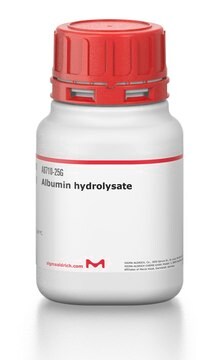H1641
Hanks′ Balanced Salt Solution 10x
Without sodium bicarbonate, 10 ×, liquid, sterile-filtered, suitable for cell culture
Synonyme(s) :
Solution saline équilibrée de Hank solution
About This Item
Produits recommandés
Niveau de qualité
Stérilité
sterile-filtered
Forme
liquid
Concentration
10 ×
Technique(s)
cell culture | mammalian: suitable
Impuretés
endotoxin, tested
Vous recherchez des produits similaires ? Visite Guide de comparaison des produits
Description générale
Application
- to culture cerebella slices from rats
- in Giardia duodenalis isolation
- as a component of the dissection media for the storage of corpus callosum slices from mice
Reconstitution
Code de la classe de stockage
12 - Non Combustible Liquids
Classe de danger pour l'eau (WGK)
WGK 1
Point d'éclair (°F)
Not applicable
Point d'éclair (°C)
Not applicable
Certificats d'analyse (COA)
Recherchez un Certificats d'analyse (COA) en saisissant le numéro de lot du produit. Les numéros de lot figurent sur l'étiquette du produit après les mots "Lot" ou "Batch".
Déjà en possession de ce produit ?
Retrouvez la documentation relative aux produits que vous avez récemment achetés dans la Bibliothèque de documents.
Les clients ont également consulté
Notre équipe de scientifiques dispose d'une expérience dans tous les secteurs de la recherche, notamment en sciences de la vie, science des matériaux, synthèse chimique, chromatographie, analyse et dans de nombreux autres domaines..
Contacter notre Service technique







